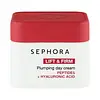What's inside
What's inside
 Key Ingredients
Key Ingredients

 Benefits
Benefits

 Concerns
Concerns

No concerns
 Ingredients Side-by-side
Ingredients Side-by-side

Water
Skin ConditioningC13-15 Alkane
SolventSqualane
EmollientPropanediol
SolventPolyglyceryl-5 Polyricinoleate
EmulsifyingBisabolol
MaskingCoco-Caprylate/Caprate
EmollientGlycerin
HumectantMagnesium Sulfate
Panthenol
Skin ConditioningGlyceryl Behenate
Emollient1,2-Hexanediol
Skin ConditioningButylene Glycol
HumectantHeptapeptide-7
Skin ConditioningAcetyl Sh-Hexapeptide-5 Amide Acetate
Skin ConditioningNicotiana Benthamiana Hexapeptide-40 Sh-Polypeptide-76
Skin ConditioningCeramide AP
Skin ConditioningCeramide EOP
Skin ConditioningCeramide NP
Skin ConditioningTremella Fuciformis Extract
HumectantAllantoin
Skin ConditioningOryza Sativa Bran Oil
EmollientArginine
MaskingGlycosphingolipids
EmollientPhytosphingosine
Skin ConditioningCholesterol
EmollientTetraacetylphytosphingosine
Skin ConditioningPolyglyceryl-6 Octastearate
EmulsifyingStearic Acid
CleansingCetearyl Alcohol
EmollientGlyceryl Glucoside
HumectantGlyceryl Stearate
EmollientHydrogenated Polydecene
EmollientHydrogenated Lecithin
EmulsifyingLecithin
EmollientXanthan Gum
EmulsifyingTocopherol
AntioxidantCarnosine
Skin ConditioningPotassium Sorbate
PreservativeSodium Benzoate
MaskingPhenoxyethanol
PreservativeCitric Acid
BufferingQuaternium-90 Bentonite
Mica
Cosmetic ColorantTriethyl Citrate
MaskingZinc Stearate
Cosmetic ColorantEthylhexylglycerin
Skin ConditioningGluconolactone
Skin ConditioningCalcium Gluconate
HumectantHydroxyacetophenone
AntioxidantWater, C13-15 Alkane, Squalane, Propanediol, Polyglyceryl-5 Polyricinoleate, Bisabolol, Coco-Caprylate/Caprate, Glycerin, Magnesium Sulfate, Panthenol, Glyceryl Behenate, 1,2-Hexanediol, Butylene Glycol, Heptapeptide-7, Acetyl Sh-Hexapeptide-5 Amide Acetate, Nicotiana Benthamiana Hexapeptide-40 Sh-Polypeptide-76, Ceramide AP, Ceramide EOP, Ceramide NP, Tremella Fuciformis Extract, Allantoin, Oryza Sativa Bran Oil, Arginine, Glycosphingolipids, Phytosphingosine, Cholesterol, Tetraacetylphytosphingosine, Polyglyceryl-6 Octastearate, Stearic Acid, Cetearyl Alcohol, Glyceryl Glucoside, Glyceryl Stearate, Hydrogenated Polydecene, Hydrogenated Lecithin, Lecithin, Xanthan Gum, Tocopherol, Carnosine, Potassium Sorbate, Sodium Benzoate, Phenoxyethanol, Citric Acid, Quaternium-90 Bentonite, Mica, Triethyl Citrate, Zinc Stearate, Ethylhexylglycerin, Gluconolactone, Calcium Gluconate, Hydroxyacetophenone
Water
Skin ConditioningGlycerin
HumectantC15-19 Alkane
SolventSimmondsia Chinensis Seed Oil
EmollientC10-18 Triglycerides
EmollientOctyldodecanol
EmollientGlyceryl Oleate Citrate
EmulsifyingMethylpropanediol
SolventPentylene Glycol
Skin ConditioningSodium Acrylates Copolymer
Carbomer
Emulsion StabilisingLecithin
EmollientSodium Gluconate
Skin ConditioningSodium Hydroxide
BufferingHydrolyzed Vegetable Protein
Skin ConditioningSodium Citrate
BufferingSodium Benzoate
MaskingSodium Hyaluronate
HumectantO-Cymen-5-Ol
AntimicrobialPolyglutamic Acid
Skin ConditioningWater, Glycerin, C15-19 Alkane, Simmondsia Chinensis Seed Oil, C10-18 Triglycerides, Octyldodecanol, Glyceryl Oleate Citrate, Methylpropanediol, Pentylene Glycol, Sodium Acrylates Copolymer, Carbomer, Lecithin, Sodium Gluconate, Sodium Hydroxide, Hydrolyzed Vegetable Protein, Sodium Citrate, Sodium Benzoate, Sodium Hyaluronate, O-Cymen-5-Ol, Polyglutamic Acid
 Reviews
Reviews

Ingredients Explained
These ingredients are found in both products.
Ingredients higher up in an ingredient list are typically present in a larger amount.
Glycerin is already naturally found in your skin. It helps moisturize and protect your skin.
A study from 2016 found glycerin to be more effective as a humectant than AHAs and hyaluronic acid.
As a humectant, it helps the skin stay hydrated by pulling moisture to your skin. The low molecular weight of glycerin allows it to pull moisture into the deeper layers of your skin.
Hydrated skin improves your skin barrier; Your skin barrier helps protect against irritants and bacteria.
Glycerin has also been found to have antimicrobial and antiviral properties. Due to these properties, glycerin is often used in wound and burn treatments.
In cosmetics, glycerin is usually derived from plants such as soybean or palm. However, it can also be sourced from animals, such as tallow or animal fat.
This ingredient is organic, colorless, odorless, and non-toxic.
Glycerin is the name for this ingredient in American English. British English uses Glycerol/Glycerine.
Learn more about GlycerinLecithin is a term for a group of substances found in the cell membranes of plants, animals, and humans. They are made up of mixture of phospholipids.
This ingredient has emollient and emulsifying properties.
As an emollient, lecithen helps soften the skin and creates a barrier to keep moisture in.
As an emulsifier, it also helps prevent water and oil ingredients from separating. Lecithin can also help ingredients be better absorbed by the skin.
This is because the phospholipids in lecithin produce liposomes. Liposomes help other ingredients get through the skin barrier.
Depending on the source of this ingredient, lecithin may not be fungal acne safe. This is because some sources of lecithin come from soybean oil, which may feed the malassezia yeast that feeds fungal acne.
We recommend reaching out to the brand you are purchasing from to inquire about the source of their lecithin.
Some other names for this ingredient include soy lecithin and deoiled soy lecithin.
Learn more about LecithinSodium Benzoate is a preservative. It's used in both cosmetic and food products to inhibit the growth of mold and bacteria. It is typically produced synthetically.
Both the US FDA and EU Health Committee have approved the use of sodium benzoate. In the US, levels of 0.1% (of the total product) are allowed.
Sodium benzoate works as a preservative by inhibiting the growth of bacteria inside of cells. It prevents the cell from fermenting a type of sugar using an enzyme called phosphofructokinase.
It is the salt of benzoic acid. Foods containing sodium benzoate include soda, salad dressings, condiments, fruit juices, wines, and snack foods.
Studies for using ascorbic acid and sodium benzoate in cosmetics are lacking, especially in skincare routines with multiple steps.
We always recommend speaking with a professional, such as a dermatologist, if you have any concerns.
Learn more about Sodium BenzoateWater. It's the most common cosmetic ingredient of all. You'll usually see it at the top of ingredient lists, meaning that it makes up the largest part of the product.
So why is it so popular? Water most often acts as a solvent - this means that it helps dissolve other ingredients into the formulation.
You'll also recognize water as that liquid we all need to stay alive. If you see this, drink a glass of water. Stay hydrated!
Learn more about Water